Breed of the Month – The German Shepherd dog
THE GERMAN SHEPHERD DOG
[ad name=”Shutzhund”]
ORIGIN AND HISTORY
German Shepherds or GSD’s, from Germany, were developed by crossing different shepherd dogs from Wurttemberg, Thuringia, and Bavaria. Dogs were bred for traits promoting sheep herding and protecting flocks from predators, such as intelligence, strength, and a keen sense of smell. These dogs performed well, but differed in appearance and ability from place to place. (1) In April 1899, Captain Max von Stephanitz, who wanted to standardize the breed, registered the first Deutsche Schaferhunde, or German Shepherd Dog. (5)(1)(2) Von Stephanitz also created the schutzhund trial – a breed test for the German Shepherd that prohibits breeding dogs that fail it. (2)
They gained international recognition after World War I, when soldiers spoke highly of them, and animal actors Rin Tin Tin and Strongheart popularised the breed. (1)(2) Dogs were imported to Britain and the USA. (2) Popularity declined after World War II, due to anti-German sentiment, but increased slowly till they became the third most popular breed in the USA. (1) At the end of World War I, it was thought that the using the word “German” would harm their popularity, and they were renamed “Alsatian Wolf Dogs.” Eventually, the “wolf dog” was dropped. In 1977, successful campaigns allowed them to be re-registered as German Shepherd Dogs.(1)
Unfortunately, modern German Shepherds have somewhat strayed away from von Stephanitz’s original ideology: that they should be bred primarily as working dogs, and that breeding must be controlled to eliminate defects quickly. Without regulating breeding, genetic health problems and poor temperaments are common. (1)
BREED CHARACTERISTICS
German Shepherds are medium sized dogs of 55 – 65 cm (22 and 26 in) at the withers, weighing between 22-40 kgs (49 + 88 lb). (1) Females are slightly smaller than males.(1) They are strong, well-muscled, agile dogs with a lively, noble appearance. The body is longer than it is tall, with smooth curves. They are not bulky and their high-set withers slope gently into a level topline. Their abdomen is firm, tucked up into the loin and the chest deep. (2) The thickly padded feet are short with well-arched toes and dark nails. Males have masculine facial features, and females feminine facial features. Their medium-sized, almond-shaped eyes are obliquely set and dark in color with a keen, intelligent expression. (2) They have moderately pointed ears, parallel to each other, (5) which are erect unless the dog is reposing or in motion.(2) The leg bones are oval instead of round. (2)
They have a double coat: The dense, straight, close-fitting, harsh outer layer is shed all year round. There is also seasonal heavy shedding. The under coat is dense and soft.(3)(5) Medium and long coats are accepted. Long haired dogs are rarer as the gene is recessive. (1) The head, legs, and paws of this breed are covered with short hair, and the neck hair is long and thick. Rich, strong coat colors are preferred. (5) The most common colors are the tan/black and red/black varieties. Both have black masks and body markings in a “saddle” shape to an over-all “blanket.” Sable, all-black, all-white, liver, blue varieties and albino are rare.(1)(5) The all-black and sable varieties are acceptable by most; but blue and liver are serious faults and the all-white is often disqualified as the white coat makes for a poor guard dog, and harder to see in snow or when herding sheep.(1)
BEHAVIOR
German Shepherds are fearless, hard working, eager, obedient and alert. (3)(4) They are direct, confident dogs but not overtly hostile. (2) They are serious in nature with strong learning abilities.(5) GSD’s are loyal and devoted to their master and show a (3)(5) willingness to please, but are also(2) an affable, laid back breed. (3) They are highly versatile, curious, strong, dependable with stamina and endurance.(3)
They thrive on human interaction and love to be close to their family, and dislike being alone.(3)(5) Shepherds bond well with people they know, but can become over-protective of their family and territory, especially if not socialized and trained correctly because they can be wary of strangers.(5)(1)(3) They can be a bit aloof, (2) which makes them approachable, but not inclined to become immediate friends with strangers.(1)
Unfortunately some GSD’s have a reputation for biting and have been banned in some places. (1) However, a well-trained and socialized German Shepherd Dog can be very safe. (1) They need firm training and proper socialization to avoid aggressive tendencies and can be easily controlled when trained by a responsible owner. Aggressive behavior is due to poor breeding and training, thus it is important for people to buy dogs from a reputable breeder!!!!! It’s a good idea to start socialization with as many people and dogs from birth. (5) They respond well to reward based training methods.(1) The German Shepherd is not recommended for the novice, apathetic, or sedentary owner. (3) German Shepherds are usually good with other pets, and they are excellent with children, being very affectionate and protective of children.(5) They will attempt to perform the task of herding anything that moves.(3)
German Shepherds are very active, (1) requiring strenuous exercise on a daily basis and enjoy securely leashed walks, family play sessions, and a large safely fenced area to romp and run freely in.(1)(5) The German Shepherd will do okay in an apartment if he is given sufficient exercise, stimulation, and attention (3) They are a comparatively inactive breed indoors, but are happiest with at least a large-sized yard. (5)
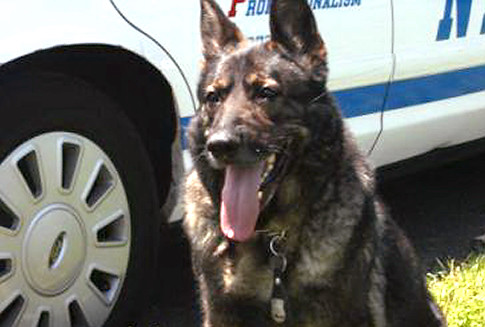 GSD’s are Happiest when they have a job – Taz was a first responder at ground Zero
GSD’s are Happiest when they have a job – Taz was a first responder at ground Zero
In his book, “The Intelligence of Dogs,” Stanley Coren ranked GSD’s third for intelligence. They learned simple tasks after only five repetitions and obeyed the first command given 95% of the time. This makes them good as police, guard, and search and rescue dogs, as they are able to quickly learn various tasks and interpret instructions better than other large breeds.They have a willingness to learn and a need to have a purpose or job to do. (1)(5)
HEALTH
The German Shepherd typically lives for about 13 years. (5)(3) Many common ailments of German Shepherds are from the inbreeding that occurred early in the breed’s life.
Hip and Elbow Dysplasia
Hip and elbow dysplasia may cause the dog to experience pain from arthritis. Hip dysplasia is a deformity of the ball at the top of the leg bone or femur, not fitting snugly into the socket it is supposed to in the pelvis. This causes the joint to be unstable and causes arthritis is later life. Some hips are so bad that the ball is not in the socket at all, and dogs with hip dysplasia should never be bred with!! It has a genetic basis but various factors such as the quality of the nutrition received as well as the correct level of calcium (low calcium is better than high for large breeds) fed to a puppy, and the amount of exercise a growing puppy has also all play a role. Potential owners of this breed should ensure that both parents have had their hips certified by X rays being taken and sent to a qualified radiologist.(5) Elbow dysplasia is an incongruity of the elbow joint, similar to the hip joint and can also cause lameness and arthritis.
Spinal Stenosis and Paralysis
GSD’s can get spinal stenosis, which is when the vertebrae fuse together and become arthritic. This can affect the function of the nerves going to the back legs. They are also prone to spinal degenerative myelopathy, (5) which is a nerve degeneration of the nerves going to the hindquarters. This causes a gradual lameness, and eventually paralysis of the hindquarters. It is not a painful condition but many dogs end up being euthanazed because they simply cannot get up anymore. Some owners purchase a cart for their German Shepherds which enables them to walk again.
Perianal Fistula
Perianal fistula is a painful condition of the skin surrounding the anus, in which small tracts open up, bleed and get infected. It is treatable but not curable. It is often considered an immune mediated condition, which means an over active immune system starts the body attacking itself. Good hygeine of the affected area, changing the diet to a hypoallergenic one, and immunosuppressive treatment such as Cyclosporin orally, Tacrolimus paste applied directly to the area or cortisone, with or without antibiotics are the mainstay of therapy.
Chronic Diarrhea
Some German Shepherds suffer from permanent diarrhea because they are deficient in enzymes to digest food, normally produced by the pancreas. This is treated with an enzyme replacement pill or raw pancreas fed to the dogs to supply them with the enzymes.
Cancer of the Spleen
They are also prone to getting Cancer of the Spleen or Hemangiosarcoma, at the age of about 10 years. See our article on Haemangiosarcoma of the Spleen in German Shepherds
Ear Infections
Due to the large and open nature of their ears, Shepherds are prone to ear infections. Ears should be kept clean and dry and checked weekly for infections.
Pannus
Pannus is an eye condition in German Shepherds in which a black membrane grows over the eye’s surface due to exposure to dry air and UV light. See our article on Pannus under our eye focus article
Other Diseases
As a large breed, they are prone to bloat. German Shepherd Dogs have a bleeding disorder called Von Willebrand’s disease. Other health concerns include epilepsy, undescended testicles (cryptorchidism), inflammation of the cornea, dwarfism, chronic eczema, and flea allergies. (3)(5)
They need daily brushing to minimize loose hair. Bathing should only be done when absolutely necessary using a mild shampoo to preserve the integrity of the coat. Because of Hip and Elbow dysplasia and spinal stenosis, the popularity of the German Shepherd as a working dog is declining with Police Forces and Armies worldwide. (5)
WORKING DOGS
German Shepherds were originally bred to herd flocks of sheep/goats (4) and are outstanding working dogs.(5) An ideal working dog is an animal that has a body and gait suitable for the arduous work that constitutes its primary purpose (5) They are a good watchdog, leader of the blind, good at tracking and rescue as well as excelling in agility and obedience. (2)
They are known for their police work, tracking criminals, patrolling troubled areas, and detection and holding of suspects. Thousands of German Shepherds have been used by the military. Usually trained for scout duty, they warn soldiers of enemies present or of booby traps or hazards. German Shepherds have even been trained to parachute from aircraft. The German Shepherd Dog is one of the most widely-used breeds in scent-work, including search and rescue, cadaver searching, narcotics detection, explosives detection, accelerant detection, and mine detection dog, amongst others. This is because of their keen sense of smell and their ability to work regardless of distractions.
At one time the German Shepherd Dog was the main breed chosen as a guide dog for the visually impaired. They excel in this field due to their strong sense of duty, their mental abilities, their fearlessness, and their attachment to their owner. (1)
Many people like to teach their German Shepherds to pull carts. Some German Shepherds also make wonderful therapy dogs who visit sick and elderly people. German Shepherds enjoy hide and seek, fetch, games, and other activities like swimming, flyball, agility, tracking, obedience, herding, and conformation. (4)
The German Shepherd requires early intensive and extensive socialization and obedience training. They will not respond to harsh or heavy-handed methods. This breed is obedient and quick to learn. Training must be done with respect, firmness, fairness, reward, and consistency. They are exceptionally talented in tracking, schutzhund, agility, obedience, fly-ball, and ring sport.
ADDENDUM BY PAM BLUMENTHAL
|
Hello Claire,
What an excellent article. My congratulations!
May I suggest that you add that the prospective GSD puppy owner asks to see the pedigrees of the parents which show the hip gradings of the puppy’s antecedents for 5 generations. The GSD Federation does not record the elbow gradings but the puppy hopeful should ask if this has been done, and what the results are, as well as what food Mom and Babies are getting. Kennels must be immaculate, and not overcrowded.The puppy also has to have been vaccinated by a veterinarian who will have examined the puppy thoroughly. I suggest to potential owners that they contact Sandringham Veterinary Hospital to satisfy themselves that everything possible has been done.
Also,a Pink Pedigree puppy, born of parents who have both passed their Breed Surveys Class 1 has top potential as far as temperament and correct construction is concerned.These ‘Royal Family’ puppies should do well in Breed Shows, and Working Trials and they make the best Companion and Protection dogs.
The genetic defects you mention should be canvassed by the potential puppy owner with the Breeder. The Breeder who does not have the time to answer all these relevant questions should be avoided.
As far as the Schutzhund Trial is concerned, this is no longer a requirement for breeding – only the hip-score.
Up until January 1 2010 the ‘Long Coat ‘was prohibited from breeding. This coat is usually a single coat, not a double coat with a thick undercoat. The Long Coat requires more grooming.The Long Coat GSD is usually taller and heavier – a true ‘Gentle Giant’.
Breeding Requirements of the GSD Federation of SOUTH AFRICA who have improved the breed standard to what it is today:
Thanks to Pam Blumenthal and Kathy Clayton for the superb pics of their German Shepherds!
Claire Demmer
MRCVS
www.yourownvet.com
REFERENCES
1. http://en.wikipedia.org/wiki/German_Shepherd_Dog
2. http://www.officialgermanshepherdguide.com/About_The_German_Shepherd/index.php
3. http://www.nextdaypets.com/directory/breeds/1100124/
4. http://www.loveyourdog.com/gsd.html
5. http://www.greatdogsite.com/breeds/details/German_Shepherd/
6. http://www.thedogfiles.com/tag/german-shepherd/
7. http://www.nydailynews.com/lifestyle/pets/2009/10/02/2009-10-02_taz_the_last_of_the_heroic_911_ground_zero_dogs_has_died.html

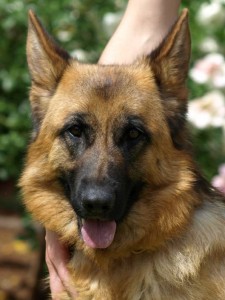
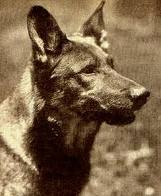
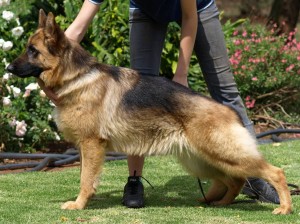
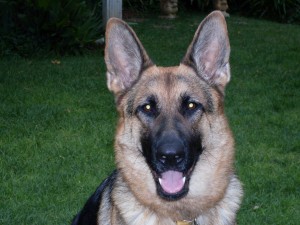
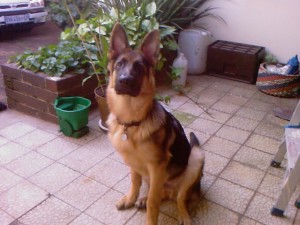
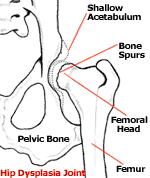
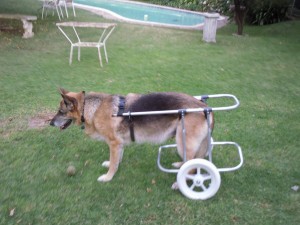
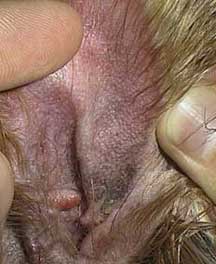
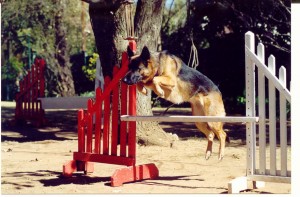
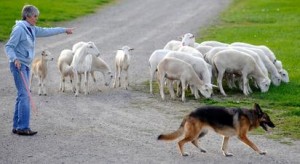

Leave a Reply
You must be logged in to post a comment.